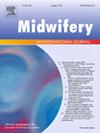Co-design of a group-based programme to facilitate adherence to pelvic floor muscle training in pregnant women in China: Describing the process of developing an intervention underpinned by the behaviour change wheel
IF 2.6
3区 医学
Q1 NURSING
引用次数: 0
Abstract
Problem
The effectiveness of pelvic floor muscle training is limited by insufficient human resource and low adherence to the exercise.
Background
Group-based pelvic floor muscle training provides a possible way to implement pelvic floor muscle training for more women. However, the feasibility and effectiveness of group-based pelvic floor muscle training still needs to be evaluated.
Aim
This study aimed to co-design a group-based programme to facilitate adherence to pelvic floor muscle training in pregnant women.
Methods
The study involved a systematic review, a survey, behaviour change theory identification and stakeholder engagement to co-design the programme.
Findings
The stakeholders discussed the barriers and mapped them to the capability, opportunity, motivation and behaviour model. The main barriers are increased cost and time for receiving the pelvic floor muscle training supervision and lack of knowledge about the importance of doing pelvic floor muscle training. Six intervention functions were identified to facilitate behaviour change in pregnant women. Then, 18 behaviour change techniques were identified and used to develop a facilitated group-based pelvic floor muscle training programme for pregnant women.
Discussion
This study has shown the importance of addressing barriers to adhere to the resulting programme. However, how to ensure the pregnant women to attend the sessions still need to be discussed.
Conclusions
Through the use of the behaviour change wheel approach, this paper describes a transparent process of translating current evidence and theoretical understanding to the co-design of a complex intervention to improve adherence to a group-based pelvic floor muscle training programme.
Registration
This study has been registered with ClinicalTrials.gov under NCT05242809.
求助全文
约1分钟内获得全文
求助全文
来源期刊

Midwifery
医学-护理
CiteScore
4.50
自引率
7.40%
发文量
221
审稿时长
13.4 weeks
期刊介绍:
Midwifery publishes the latest peer reviewed international research to inform the safety, quality, outcomes and experiences of pregnancy, birth and maternity care for childbearing women, their babies and families. The journal’s publications support midwives and maternity care providers to explore and develop their knowledge, skills and attitudes informed by best available evidence.
Midwifery provides an international, interdisciplinary forum for the publication, dissemination and discussion of advances in evidence, controversies and current research, and promotes continuing education through publication of systematic and other scholarly reviews and updates. Midwifery articles cover the cultural, clinical, psycho-social, sociological, epidemiological, education, managerial, workforce, organizational and technological areas of practice in preconception, maternal and infant care.
The journal welcomes the highest quality scholarly research that employs rigorous methodology. Midwifery is a leading international journal in midwifery and maternal health with a current impact factor of 1.861 (© Thomson Reuters Journal Citation Reports 2016) and employs a double-blind peer review process.
 求助内容:
求助内容: 应助结果提醒方式:
应助结果提醒方式:


